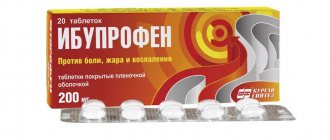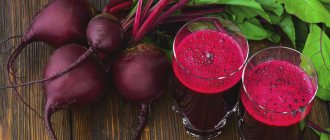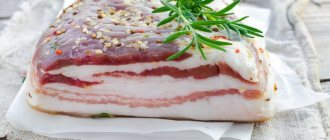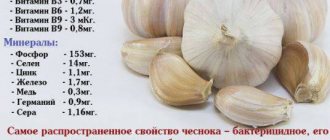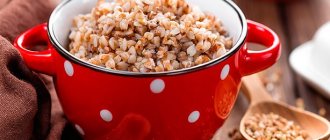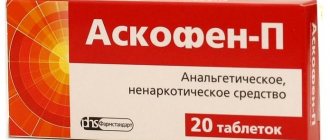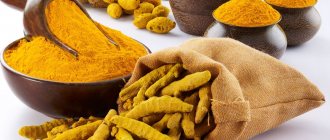Product value
A study of lard showed that it contains (per 100 g of product with a calorie content of 901 kcal):
- 100 g fat;
- 5 mg vit. E (tocopherol);
- 5 mg vit. D (calciferol);
- 8 m choline (Vit B4);
- 0.29 mg selenium;
- 36 mg zinc;
- 37 mg phosphorus;
- 19 mg iron;
- 17 mg copper;
- 0.002 mg manganese.
Lard contains a unique combination of beneficial components
The composition of lard also contains essential fatty acids (vit. F):
- oleic;
- linolenic;
- linoleic;
- palmitic;
- arachidonic
Essential fatty acids are an important component for the human body, as they participate in metabolic processes, clean blood vessels from cholesterol plaques, and are necessary to maintain hormonal levels and immune reactions. And without vitamins, selenium and zinc, human health can deteriorate.
Lard is a unique product that is easily digestible, since its melting point is 37 degrees, and does not create an overload for the liver. It is an excellent choleretic agent. Thanks to its ability to remove toxins and radionuclides, it improves the functions of the liver and the entire digestive tract, which contributes to the healing and rejuvenation of the body as a whole.
Constant consumption of lard increases the physical endurance of the body, helps strengthen the immune system and overall vitality. This is especially important during the winter season. There is also an improvement in brain activity, the functioning of the renal and cardiovascular systems, harmful cholesterol is eliminated, and blood counts are normalized (thanks to arachidonic acid). Regular consumption of lard is a good prevention of cancer.
Benefit
The subcutaneous fat layer contains a large amount of nutrients, vitamins and macroelements.
| Contains | Acid content |
| Fats, manganese, copper, zinc, iron, selenium, phosphorus. Contains vitamins: E, F, D, B4. | palmitic; linoleic; oleic; linolenic; arachidonic |
Fatty acids contribute to:
- Proper metabolism;
- Cleansing blood vessels from cholesterol;
- Removing harmful toxins from the liver;
- Improving kidney function;
- Charge the body with energy;
- Prevention of cancer and pulmonary diseases;
- Cleansing the body of radionuclides.
Adequate intake of lard helps improve immunity, proper functioning of the stomach and cardiovascular system. Nutritionists advise eating bacon in the first half of the day.
Consumer Reviews
- I can't imagine my life without lard. Living in Ukraine, you see this product everywhere: at a party, in a village, at the market. I like smoked food most of all, but after learning about its dangers, I decided to give it up. It’s better to just eat salted lard. There are more benefits, but no less pleasure from it. I can’t say anything about the effect on the body; I have nothing to compare with and it’s difficult to assess the difference between using and refusing the product. This is because I have eaten it all my life and I can say for sure that there were no unpleasant sensations from it.
- Unfortunately, for me lard is a taboo. And not because I am against it, but on the contrary - it tastes so good to me that I overeat my daily allowance. As a result, we end up with extra pounds. I hope that someday I will learn to control my eating behavior and be able to limit myself to 30 grams of lard per day.
- When my menstrual cycle was disrupted, in addition to the main therapy, the doctor also prescribed me to include various foods with polyunsaturated (and mono) fats in my diet. I am not naturally slim, so I have struggled with excess weight all my life. I got used to limiting myself in food, especially fatty foods. After these problems, I reviewed a lot of information about fats and came to the conclusion that I was wrong before. I started eating nuts, avocados, butter and even lard. Of course, everything is within reasonable limits. After a couple of months, everything returned to normal, and now I don’t experiment with my health, but learn to choose healthy products. And the main thing is that now I’m not afraid to eat lard!
Source
Effect of lard on blood pressure: increases or decreases
The effect of pork subcutaneous fat on blood pressure has been studied, and certain conclusions have been drawn:
- The layer of subcutaneous fat of a pig affects the condition of blood vessels. If a person moves little and consumes lard in large quantities, then he inevitably begins to thicken the walls of his blood vessels. Hence the disruption of blood flow, increased pressure on the walls of the arteries.
- The salt in the product affects the volume of circulating blood inside the vessels, increasing it. This leads to elevated blood pressure readings.
- After eating salty food, the blood becomes viscous, the heart has to increase its rhythm to increase the speed of blood flow. This has a negative effect on the human condition.
- Excessive consumption of lard increases blood pressure. But the product has a beneficial effect on the body of those who suffer from hypotension.
An increase in blood pressure when consuming a fatty product is inevitable. If blood pressure rises slightly, this leads to activation of thought processes and clear brain function. But if you have constantly high blood pressure, you should not overuse the product.
Benefits and harms
Lard is a high-calorie product, 100 g contains 770-800 kcal, so it is easy to get enough of it and will have enough energy for a long period. In addition, it contains selenium and many vitamins, minerals, aliphatic monobasic carboxylic acids, arachidonic acid and other beneficial substances.
Don't tolerate high blood pressure
Now hypertension can be cured by restoring blood vessels...
>
All this allows:
- strengthen the functioning of the nervous system;
- prevent the development of cancer;
- get rid of toxins;
- has a beneficial effect on the functioning of the gastrointestinal tract and brain;
- increases resistance to infections;
- maintains lipid balance.
It is not recommended to consume lard for those people who have a history of:
- obesity;
- liver and gallbladder diseases;
- inflammation of the pancreas;
- gastrointestinal diseases in the acute stage;
It is undesirable to abuse it even for healthy people, so as not to cause harm to health.
Rules for eating lard
The daily norm of pork fat for an adult healthy male body is about 70 g, for the fair half - about 50 g. Hypertensive patients can eat up to 50 g of the layer no more than once a week; if consumed daily, the portion must be reduced. Both old people and small children are allowed to eat the subcutaneous fat layer of the piglet in small quantities.
What is important to remember for hypertension:
- To minimize the harmful properties of a fatty product, you need to eat it before lunch. In this case, the consumed calories will have time to be processed and will not be deposited in the body as unnecessary lipids. However, fat layer is not recommended for breakfast. The product is quite heavy and may cause abdominal pain.
- Do not exceed the daily or weekly norm. In case of overeating, it is important to immediately rinse the stomach and reduce blood pressure.
- It is recommended to exclude fried and smoked lard from the diet. This product contains a lot of salt, spices and unnecessary carcinogens.
- In the cold season, to further strengthen the immune system, it is allowed to consume pork fat with the addition of garlic and rye bread. This is an auxiliary source of substances beneficial to the body, and this combination of products helps strengthen the walls of veins and arteries.
- You should not eat highly salted pork fat. The fact that salt retains fluid in the human body is fraught with adverse consequences for hypertensive patients.
- An excess of spices is dangerous due to a possible allergic reaction and increased blood pressure. The best option is lightly salted lard.
- It is better to eat lard with a vegetable salad, a light side dish or unleavened bread. This approach will significantly reduce the harm from consumed fat.
- It is strictly forbidden to use lard instead of oil for frying. If we do not take into account the fact that fried foods are generally contraindicated for hypertensive patients, and fresh, lightly salted lard can cause minimal harm to the body, then harmful cholesterol and trans fats that arise during the frying of pork fat can significantly aggravate the patient’s condition.
By following these simple recommendations, a person with hypertension will be able to protect themselves from a host of undesirable consequences.
Attention: with low blood pressure, lard is a particularly important product. Pork fat quickly saturates the body and promotes the breakdown of lipid acids.
Harmful properties of lard
Lard may not lower blood pressure, but increase it. In patients with hypertension, cholesterol plaques form on the walls of blood vessels. And if you abuse lard, the condition of the blood vessels may worsen, which will lead to another increase in pressure. This is due to the bad fat and cholesterol found in lard. Abuse of this product can lead to disruption of the intestinal tract and metabolic processes (obesity).
There is a risk of infection with helminths when consuming lard, if sanitary and hygienic rules have not been followed: acceptable conditions for keeping the pig, its diet, conditions for cutting the carcass.
With excessive consumption of lard, cholesterol plaques form in the blood vessels, which is especially dangerous for hypertension
The relationship between blood pressure and fat
Issues of proper nutrition are very relevant for every healthy person, not to mention hypertensive people. Lard, being one of the favorite foods, leads many cardiology patients to wonder: does it increase blood pressure or lower it? Is it worth using this product for hypertension and will it harm the body affected by the disease? The answers to these questions will be determined by a number of factors.
World nutritionists are quite wary of the benefits of lard and its effect on the body. In most nutritional systems developed by doctors, the subcutaneous fat layer of the pig is prohibited or strictly limited. Hypertension is no exception. Although lard stimulates the functioning of the cardiovascular system, the product does not combine well with the disease.
This is expressed by the following factors:
- Pork fat contains cholesterol and promotes its deposition in arteries and veins. Vascular atherosclerosis is a fairly common companion to arterial hypertension. With excessive consumption of lard, the condition can only be aggravated: cholesterol plaque will be deposited more and more on the walls of blood vessels, reducing the clearance between them, and the blood flow will resist them more and more, and blood pressure levels will only increase.
- Pork lard is a very high-calorie product, so regular consumption of it in large quantities contributes to the appearance of extra pounds. In most cases, hypertension is accompanied by obesity, and the diet of a hypertensive patient involves avoiding fatty foods and limiting daily caloric intake in order to return the body to its original shape.
- The subcutaneous fat layer of a piglet is usually salted or smoked before consumption. Both methods involve the use of large amounts of salt. And salt, as you know, retains fluid in the body, promotes swelling and puts additional stress on the heart muscle, which already has a hard time working. Excessive strain on the heart also contributes to changes in blood pressure.
Obviously, the answer to the question that interests many is clear: you should not eat lard if you have hypertension. Its use increases both systolic and diastolic blood pressure by several mm Hg. Art.
Important: in case of severe arterial hypertension, nutritionists and cardiologists recommend giving up pork fat.
Contraindications
Lard is a very high-calorie product! It is not recommended for use by overweight people.
Contraindications also include:
- Chronic diseases of the gallbladder, kidneys and liver;
- Obesity and diabetes;
- Chronic hypertension stages 2-3;
- Diseases of the gastrointestinal tract;
- Atherosclerosis.
Whether blood pressure rises from fat should only concern hypertensive patients. It all depends on the individual characteristics of the body and human health. It is unlikely that serious complications should be expected from a small piece. But abuse and consumption of it in large quantities will undoubtedly cause stress on the kidneys, heart and blood vessels.
THERE ARE CONTRAINDICATIONS CONSULTATION WITH YOUR DOCTOR IS REQUIRED
Author of the article Svetlana Anatolyevna Ivanova, general practitioner
The danger of overusing lard
The consequences of excessive consumption of lard are mainly expressed by a sudden increase in blood pressure. Frequent changes in blood resistance levels can ultimately lead to stroke, atherosclerosis or heart attack.
Lard is a product consisting of 100% lipids, and its excessive consumption can cause obesity.
If technology and sanitary and hygienic standards were not followed when raising a pig and producing the final product, you can become infected with parasites or simply be poisoned.
Overeating lard in people with gastrointestinal disorders can cause an attack or exacerbation of a chronic disease.
Pork fat is a very valuable and healthy product, but its excess can only harm a hypertensive patient. To avoid unpleasant consequences, lard should be eaten infrequently and in small quantities.
How to use it correctly?
It is recommended for a healthy person:
- up to 69 g per day – for men;
- up to 49 g per day – for women.
For patients with hypertension, despite the fact that lard raises blood pressure, nutritionists recommend taking it 20-30 g per day. In small quantities it is indicated for both children and the elderly.
Important! This product should be consumed fresh (unsalted or lightly salted). Salted, smoked or fried lard does not contain those beneficial substances that are especially valuable for humans. Partially passing into a passive form, the properties of fatty acids are already a harmful component for the body.
It is recommended to take the product with black bread and garlic, as this is an additional source of vitamins, and this combination also helps strengthen the walls of blood vessels and lower blood pressure.
So, with high blood pressure, you can and should eat lard in small quantities. Here, fat and pressure are very compatible things. This product is especially necessary for low blood pressure - hypotension, in which it is important to raise it.
Since subcutaneous fat does not contain carbohydrates, it is used in dietary nutrition (low-carbohydrate diet). In this case, it gives a feeling of fullness and improves the breakdown of fats.
The combination of lard with garlic and black bread is especially useful
Is it possible to eat lard if you have hypertension: how does lard affect blood pressure?
Hypertension is treated not only with medications. In addition, you must adhere to a healthy lifestyle and follow certain diets.
When consuming foods that are incompatible with the disease, complications are possible in the form of worsening the course of the disease.
To understand whether it is possible to eat lard if you have hypertension, you need to become familiar with its chemical composition and mechanism of action on the human body.
Product value
Lard contains a lot of animal fats, so it should be consumed in limited quantities.
Lard is a healthy product, but only if it is consumed correctly. It is rich in vitamins and minerals that can prevent the occurrence of various diseases, including cancer. In addition, lard improves brain and kidney function. Its chemical composition and nutritional value are indicated in the table based on 100 grams of product:
Vitamins Micro- and macroelements Other substances Nutritional value
| A | Calcium | Fatty acid | Calories 841 kcal |
| Retinol | Phosphorus | Cholesterol | Fat 92.8 g |
| E | Iodine | – | Proteins 1.4 g |
| RR | Iron | – | Water 5.7 g |
| Niacin | Sodium | – | – |
| – | Potassium | – | – |
| – | Chlorine | – | – |
A compress with lard is very useful during diseases of the upper respiratory tract. It promotes better mucus discharge and relieves inflammation. To do this, you need to grind 50 grams of the product in a meat grinder, add 50 milliliters of good vodka to the resulting mass and mix. Then you should apply a compress to your chest through double-layer gauze. Holding time 1 hour.
How does lard affect blood pressure?
Let's look at how lard affects blood pressure - whether it increases or decreases it. Among the components of lard there is a component such as cholesterol, which contributes to the formation of plaques on the walls of blood vessels. Because of this, they narrow, the blood circulation process is disrupted, as a result of which blood pressure rapidly increases.
In addition, the product contains a large amount of animal fats, which are not recommended for hypertensive patients. It is also worth noting that lard is eaten salted, and consuming salt with high blood pressure is extremely undesirable. After reviewing the characteristics of the product components, we can conclude that lard is prohibited for hypertension.
Restrictions exist not only with high blood pressure, but also with hypotension. Lard also has a negative effect on low blood pressure, but it can be eaten in limited quantities - no more than 100 grams per week, and then fresh. This applies to those cases when there is an irresistible feeling to eat a piece of the “forbidden fruit”.
Harmful properties of lard
Due to the high content of harmful cholesterol and animal fats in its composition, lard can:
- Impair metabolism, which leads to excess weight;
- Disturb the functioning of the heart and blood vessels, and as a result increase blood pressure;
- Cause gastrointestinal upset;
- Lead to infection of the body with helminths (in case of improper processing of the product).
How to use it correctly?
Lard is not recommended for use if you have high blood pressure.
For an adult, the daily intake of the product should not exceed 9-12 g, and the maximum weekly dose should not exceed 100 g. We are talking about a healthy body, and if there are no contraindications.
It is this amount, according to experts, that does not cause much harm. When cooking, smoking and frying, the active substances in the product decompose, which is not very beneficial for the body.
It is better to give preference to salted or marinated lard.
Lard can be given to children, but only from the age of two (if the child is no longer breastfed). It is better to use it boiled, for example, add it to porridge. The maximum recommended intake is 10-15 grams per week.
How to choose quality lard?
It is better to purchase lard not in supermarkets, but in the market, from trusted suppliers. The first thing you should pay attention to is a document confirming the passage of a sanitary inspection, the presence of a brand, and veterinary certificates.
Next, you need to decide which part of the body you want to cut from (cheek, neck, back or abdominal part). The softest fat is from the side and back. This product is well suited for frying, boiling and smoking.
Fat from the abdominal part usually has a thin skin and layers of meat. Suitable for cooking in any way, but salted and fresh it will be a little tough.
The cut from the neck and cheek has thicker skin and a denser consistency. It is best to prepare such lard by smoking, frying or baking. In addition to these indicators, there are also criteria for choosing a quality product:
- Consistency - pierce the lard with a knife (as a rule, any seller has one). Good lard should be pierced without much effort. If the knife enters tightly, this may indicate that there are veins and the lard will be harsh. The skin should be dense, but also easy to pierce with a knife. The surface of the product should not be sticky and/or wet. When pressed, high-quality lard should melt slightly from the warmth of your finger;
- Smell - burn a corner of the skin with a match; if there is an unpleasant smell of urea, it means it is boar lard. In most cases, heat treatment does not produce results and the unpleasant odor remains. The smell of good lard should resemble a sweet, milky aroma;
- Color - fresh lard is characterized by a white color with a slightly pink tint. Obvious blood stains indicate that the pig was slaughtered incorrectly and the taste of the product will be far from ideal. If the lard has grayish or yellowish tints, it means it is not fresh;
- Type - optimal thickness 3-5 centimeters. The skin should be thin, clean, without bristles;
- Taste - high-quality lard has a delicate creamy taste, it melts in the mouth and is easy to chew.
On some Internet resources you can find topics such as “treatment of hypertension with lard”, “benefits of lard for hypertension”, and the like. In fact, you should not trust such stories, because you can seriously harm your body. If you want to experiment, then first of all, be sure to consult with your doctor.
Source: https://gipertonia.guru/narodnye-metody/salo-pri-gipertonii/
The importance of proper nutrition
Maintaining a healthy diet minimizes the risk of developing and developing high blood pressure. If you have hypertension, you need to limit your intake of salt, complex fats, and avoid alcohol. It is necessary to eat foods that improve heart rate and reduce the amount of cholesterol in the blood. Food should be rich in plant fiber, so it is important for hypertensive patients to include fresh fruits and vegetables in their diet. Products containing high doses of caffeine are dangerous for hypertension and arterial hypertension.
If you have high blood pressure, you should avoid the following categories of foods:
- alcoholic drinks;
- baked goods and fresh baked goods, ice cream and sweets;
- excessive consumption of salt and salty foods;
- various fast foods;
- The risk group includes dairy products with a high fat ratio (homemade milk, sour cream, full-fat kefir, butter and hard cheeses);
- semi-finished meat products and offal;
- pork and fatty poultry;
- fish roe, crayfish and crabs.
If blood pressure needs to be increased, this does not mean that it is necessary to eat foods in excessive quantities that are undesirable for hypertensive patients. Dried fruits and honey are useful for increasing it. Tinctures of ginseng, lemongrass, eleutherococcus and St. John's wort are used. They are drunk strictly as prescribed by the doctor, in the indicated dosages. The diet includes meat, fish, vegetables, honey and cereals. With hypotension, the importance of proper and healthy nutrition remains relevant in the same way as in the case of hypertension.
While increasing blood pressure is extremely undesirable for some people, it is vital for others. Blood pressure is reduced by a specially selected diet rich in vitamins and minerals. In case of hypertension, a healthy lifestyle, moderate physical activity and a balanced diet can significantly improve the condition of blood vessels and help improve the quality of life.
Is it possible to eat lard with hypertension - No hypertension
A diet for hypertension is an effective way to normalize blood pressure and reduce the risk of complications by 10 times. Often the cause of hypertensive heart disease is considered to be excess weight. In this case, diet No. 10 for hypertensive patients will help normalize blood pressure (blood pressure) levels and get rid of health problems.
Basic Rules
Nutrition for hypertension is based on several rules. When dieting, hypertensive patients need:
- Stop drinking alcohol.
- Choose products carefully.
- Eat right and in small portions.
A diet for high blood pressure means limiting:
- products that stimulate the nervous system;
- consumption of sweets;
- foods high in salt;
- animal fats.
Important: Often both men and women have problems with blood pressure due to smoking. Therefore, the bad habit should also be abandoned.
With diabetes, patients are advised to give up sweets; the diet does not prohibit sweets for hypertensive patients. But you shouldn’t eat confectionery in large quantities. The reason for this is simple carbohydrates, which affect the liver, increasing the load.
With atherosclerosis, pressure increases due to the fact that fat accumulates on the walls of blood vessels, the lumen of the vessel gradually fills, and an atherosclerotic plaque appears. A diet for atherosclerosis for hypertensive patients helps lower blood pressure and slow down the progression of the disease.
Attention! For atherosclerosis, a diet for the treatment of hypertension is part of complex therapy, which is considered the most effective.
Nutrition for high blood pressure should be:
- Balanced.
- Rich in potassium and magnesium.
- Fractional.
In women, problems with excess weight arise more often, so many patients are familiar with the word “diet”. But for hypertensive patients, nutrition should be special. Fasting should be avoided, since the “starvation diet” is not indicated for hypertensive patients. It can negatively affect the condition of the heart and blood vessels, affecting blood flow to the brain.
What foods should hypertensive patients avoid?
A diet for hypertension involves avoiding:
- pork, lamb and other fatty meats;
- dairy products and high-fat cheeses;
- coffee and strong tea;
- you can’t eat lard and processed foods;
- drink sweet sparkling water.
The diet indicated for hypertensive patients with high blood pressure is similar to the diet for diabetes mellitus. Patients should not drink sweet soda or drinks that contain caffeine; it excites the nervous system and increases blood pressure.
Attention! A diet for arterial hypertension helps reduce the risk of complications by 10 times and slow down the progression of the pathology.
Diets for hypertensive patients exclude the consumption of fatty, fried and salty foods. Fatty foods lead to atherosclerosis and put stress on the heart and blood vessels. You should not eat not only fatty meat, but also lard.
Important: Also, if your blood pressure is high, you should not eat salty foods. This leads to an increase in the amount of fluid in the body. As a result, the load on the heart and kidneys increases.
Nutrition for hypertension is considered one of the components of complex therapy, as for diabetes. Dietary restrictions for hypertensive patients help normalize indicators and achieve greater results.
What products are possible?
Products that can and should be included in the menu for hypertension:
- Vegetables and fruits.
- Vegetable fats.
- Chicken and fish.
- Low-fat fermented milk products.
Attention! Lard, fatty meat and caviar are prohibited - these are the basic rules of the diet for hypertensive patients.
Proper nutrition for hypertension and high blood pressure is based on:
- Moderate food consumption.
- Tracking food calories.
- Limiting salt intake.
A salt-free diet for hypertensive patients: you should consume no more than 5 grams of salt per day, you should salt foods once, and avoid consuming processed foods. Frying lard or eating it salted and smoked is also prohibited.
Food should be rich in fiber, B vitamins, food enriched for hypertensive patients with potassium, magnesium and other vitamins. As with diabetes, you need to monitor the amount of fluid a person consumes during the day. You need to completely change your lifestyle, play sports and stop drinking alcohol.
Recipes for hypertensive patients
Following nutritional rules or a diet is useful for hypertensive patients and overweight people; every extra kilogram increases blood pressure levels by 1 mm Hg, so by losing 10 kg you can significantly reduce your blood pressure levels.
Products can and should be selected, assessing general well-being and taste preferences; food should not be bland, spices and seasonings can be added to it.
What seasonings will help with high blood pressure and are included in a diet designed for hypertensive patients:
- parsley;
- cinnamon;
- dill;
- black pepper;
- turmeric.
Important: Healthy recipes can be varied; familiar food will acquire a new taste and aroma if you add a whisper of seasoning to it.
If you need to reduce the calorie content of chicken meat by almost 2 times, then it is enough to remove the skin from it and simmer it, rather than fry it in oil.
What is diet number 10?
A low-cholesterol diet for patients with hypertension is table No. 10, food that meets the following rules:
- does not have high fat content;
- well digested;
- does not affect blood sugar levels.
The patients are given a menu for the week. The diet allows hypertensive patients to eat the following foods:
- wholemeal bread;
- fish and chicken;
- cereals, cereals;
- low-fat dairy products.
Attention! Diet No. 10 for hypertension can also be prescribed for diabetes; it affects a person’s lifestyle, so it is rarely recommended for children and pregnant women.
Meals for patients with hypertension are distributed over a week, the menu is prepared in advance so that the food does not seem bland and monotonous, in case of diabetes it is forbidden to eat sweets, and in case of hypertension it is advised to replace them with nuts and dried fruits. At the same time, it is not forbidden to treat yourself to mousse or fruit jelly.
Table number 10 is not salted lard with fried potatoes, but stewed, boiled or baked food with a moderate amount of salt. Some fruits and vegetables are served raw, without heat treatment. Healthy and tasty recipes can be found on the Internet, but following diet No. 10 affects a person’s lifestyle and performance, so it is often prescribed to people aged 50–60 years.
A diet for stage 2 hypertension or table No. 10 is indicated for:
- Diabetes of any degree.
- Kidney problems.
- Presence of heart and vascular diseases.
Food helps not only normalize blood pressure levels, give up junk food, and start leading a healthy lifestyle. Healthy recipes will help you reduce the amount of medications you consume and get rid of excess weight. In a week a person can lose 5 kg or more.
Attention! A diet for stage 2 hypertension means consuming no more than 2 thousand calories per day.
But diet is not everything for a hypertensive patient; a healthy lifestyle means giving up bad habits and moderate physical activity. Healthy foods, walks and exercises will help you see positive results within a week.
For diabetes mellitus and kidney problems, a diet for hypertensive patients is a component of complex therapy. Properly selected food helps normalize the patient’s condition, optimize the functioning of his body and achieve results within a week from the start of treatment.
Source: https://gipertensianet.ru/mozhno-li-est-salo-pri-gipertonii.html
Lard is eaten for weight loss
Surprisingly, this valuable product is used in separate programs for those who want to lose weight. For this purpose, 30 g/day of fresh unsalted lard is indicated on an empty stomach without anything as a breakfast. Take: 10 days, then break for 20 days. This promotes active breakdown of fats. According to endocrinologists, by practicing such a “diet” for 2-3 months, you can lose weight well.
Important! When eating lard, you do not need to wash it down with water or other liquid, as this disrupts the digestion process and the fat is poorly digested and absorbed. You can drink water an hour after taking the product.
Does lard affect blood pressure?
One of the most popular products in the world, and especially for the Slavic peoples, is lard. This is the subcutaneous fat layer. It has very valuable nutrients and vitamins, micro and macro elements necessary for the body.
Its use is indicated for various diseases. Some people ask the question: “Does fat raise or lower blood pressure?” After all, this is a popular and favorite product of many people.
And they would not want to completely abandon it in case of such a pathology as high blood pressure.
Who is contraindicated for
Fatty layers are harmful for those who suffer from excess body weight. It leads to fat deposits on the hips and sides. It is especially harmful to use it for those who move little or are engaged in sedentary work. Physical inactivity, together with daily consumption of fatty foods, will cause arterial hypertension.
The product is prohibited for patients with:
- chronic hypertension;
- cholecystitis and pancreatitis;
- metabolic disorders.
Before you cut salted salsa and serve it on the table, you need to think about what the body’s reaction to this product will be. Everyone should know that it is better to eat a little of it to avoid serious consequences for themselves.
Hypertension is known to many people; people often encounter this disease, so products that increase blood pressure are strictly prohibited by doctors for this category of patients. There is another type of disease associated with similar disorders of the body, when the pathological process develops in the opposite direction. Hypotension is rare, but can seriously worsen a person’s health and cause a lot of discomfort. In this case, foods that increase blood pressure are necessary in the diet. A lot depends on nutrition; with the help of the right menu, you can significantly reduce the risk of developing complications of any disease and help your body cope with various problems.
How does lard affect a person’s blood pressure: does it increase or decrease it?
In Russia and the CIS countries, lard is the main product for table decoration. Many people consider it tasty and eat it every day, without thinking about the benefits or harm. How does this product affect the human cardiovascular system?
Increases or decreases blood pressure
Fat increases blood pressure. This is a salty product and even a small amount of the product can cause an increase in systolic and diastolic blood pressure from 10 to 40 mmHg.
If a person leads a sedentary lifestyle, then when consuming animal fats there is a risk of atherosclerotic plaques appearing in the vessels.
In clinical recommendations for hypertensive patients, cardiologists advise reducing the consumption of lard to a minimum.
If you have persistent arterial hypertension, you should completely abandon it. It is better to replace lard with lean poultry meat.
Dosage for hypertension
In small quantities, lard is a very healthy product. An adequate dose for a healthy person is considered to be 50 grams of product per day. It is recommended to use it with a break and no more than 3 days a week.
If you have high blood pressure, it is better to reduce the dose by half.
It is recommended to consume lard with plenty of plant foods. An excellent solution would be to combine it with vegetable salads, garlic, cabbage, rye bread or crispbread.
Benefit
The subcutaneous fat layer contains a large amount of nutrients, vitamins and macroelements.
Contains acids
| Fats, manganese, copper, zinc, iron, selenium, phosphorus. Contains vitamins: E, F, D, B4. | palmitic; linoleic; oleic; linolenic; arachidonic. |
Fatty acids contribute to:
- Proper metabolism;
- Cleansing blood vessels from cholesterol;
- Removing harmful toxins from the liver;
- Improving kidney function;
- Charge the body with energy;
- Prevention of cancer and pulmonary diseases;
- Cleansing the body of radionuclides.
Adequate intake of lard helps improve immunity, proper functioning of the stomach and cardiovascular system. Nutritionists advise eating bacon in the first half of the day.
Research by scientists
Recent research by scientists from the University of Munich confirms this hypothesis. They discovered that pig fat contains arachidonic acid, which has a beneficial effect on strengthening the heart muscle. It is also involved in fat metabolism and performs a number of protective functions.
Scientists' conclusions:
- The acids in its composition have a choleretic effect;
- The liver is saturated with “good” cholesterol, which displaces the “bad” one;
- The monounsaturated oleic acid contained in the product prevents the kidneys from oxidation and prevents atherosclerosis;
- Removes toxic and harmful substances from the body.
In the final protocol, German experts classify lard as a healthy animal fat. Many doctors even recommend it in the menu for a therapeutic diet for patients suffering from cardiovascular diseases. It is important to maintain the minimum dose and consume only a high-quality product.
Before use, it is better to consult your doctor.
Harmful properties
The salt in lard promotes fluid retention and causes swelling. Blood circulation is impaired and blood pressure rises.
Hypertensive patients are not recommended to combine lard with potatoes, white bread, salty foods, ketchups, mayonnaise, and hot spices.
You should not fry it, over-salt it or smoke it.
Contraindications
Lard is a very high-calorie product! It is not recommended for use by overweight people.
Contraindications also include:
- Chronic diseases of the gallbladder, kidneys and liver;
- Obesity and diabetes;
- Chronic hypertension stages 2-3;
- Diseases of the gastrointestinal tract;
- Atherosclerosis.
Whether blood pressure rises from fat should only concern hypertensive patients. It all depends on the individual characteristics of the body and human health. It is unlikely that serious complications should be expected from a small piece. But abuse and consumption of it in large quantities will undoubtedly cause stress on the kidneys, heart and blood vessels.
THERE ARE CONTRAINDICATIONS CONSULTATION WITH YOUR DOCTOR IS REQUIRED
Author of the article Svetlana Anatolyevna Ivanova, general practitioner
Source: https://giperton.com/salo-pri-davlenii.html
Salo in folk medicine
Lard can increase blood pressure, which is definitely a minus. But this applies to a salty product. If consumed fresh, it will lower the patient’s blood pressure over time and even help to overcome a hypertensive crisis. After all, there should be fewer cholesterol plaques on blood vessels thanks to its proper use.
Lard is widely used in folk medicine. It can relieve joint pain, for example. The product is melted and the resulting fat is lubricated on the joints. Then the treated area should be covered with compression paper, then wrapped well. A down scarf is perfect for these purposes. This procedure lasts all night. You can also add honey to the resulting fat for rubbing.
Old lard will save you from mastitis. Apply this product to the inflamed area for a while.
To get rid of toothache, a piece is placed between the gum and the place where it aches. The pain will subside fairly quickly.
People are very worried about such an ailment as heel spurs. An ointment is prepared from lard to combat this scourge. You need to take 100 mg of fresh product, the same amount of vinegar essence and one chicken egg. The components are mixed and left for a short period until the pork product becomes liquefied. When this happens, the ointment is ready. The sore heel needs to be steamed, ointment applied, a cotton pad on top and wrapped with something. Some patients felt relief already on the fifth day of such treatment. You need to keep the ointment fixed all night.
How to choose the highest quality lard?
The best subcutaneous fat can be purchased from those people who themselves raise this livestock. You need to go to the village or visit the market. The buyer independently evaluates the appearance, smell, and taste.
The most delicious are the back of the animal and its side. The texture is delicate, there is no layer of meat, the thickness is significant - 4 cm. The skin is quite thin.
Pink color is unacceptable, because its presence indicates the presence of blood and this biological fluid was poorly drained from the carcass. The taste of the product may be completely bad, and infection with parasites due to the presence of blood is also possible.
The greasy crust is an important indicator that needs to be taken into account. It shouldn't be hard. The pulp itself is quite high quality, if it melts in your mouth, it is very soft and pleasant.
If the buyer purchased an unsalted product, then it must be placed in the freezer. Thanks to this, nutrients will be preserved and the goods will not be lost. When frozen, you can cut the product and eat it with pleasure.
[adsp-pro-1] [adsp-pro-2]
Hypertension
